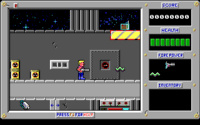Duke Nukem (video game)
| Duke Nukem | |
|---|---|
|
Title screen of Episode One | |
| Developer(s) | Apogee Software |
| Publisher(s) | Apogee Software |
| Designer(s) |
Todd Replogle Scott Miller Allen H. Blum III |
| Artist(s) |
George Broussard Jim Norwood Allen H. Blum III |
| Composer(s) | Scott Miller |
| Series | Duke Nukem |
| Platform(s) | MS-DOS |
| Release date(s) |
MS-DOS |
| Genre(s) | Platform |
| Mode(s) | Single-player |
Duke Nukem is a 2D platform game developed and published by Apogee Software, featuring the adventures of the fictional character Duke Nukem.
Gameplay

The main objective of the game is to get to the exit of each level, while destroying enemies and collecting points. Many objects onscreen can be shot including boxes, obstacles and blocks. Besides points, some collectibles include health powerups, gun powerups, and some inventory items with special abilities. The final level of each episode has no exit, and is instead completed by finding and defeating Dr. Proton.
At the end of every level (with the exception of the last level in each episode), the player can receive up to seven 10,000 point bonuses, earned by making certain achievements in the level, such as destroying all cameras. At least two other Apogee titles, Duke Nukem II and Rise of the Triad, have similar end-of-level bonuses.
Plot
The game is set in the year 1997 (which was the "near future" at the time of game release). Dr. Proton is a madman, determined to take over the world with his army of Techbots. Duke Nukem, the eponymous hero, takes upon the task of stopping him. The first episode takes place in the devastated city of Los Angeles. In the second episode, Duke chases Dr. Proton to his secret moonbase. In the third episode, Dr. Proton escapes into the future, and Duke pursues him through time, to put a permanent end to his mad schemes.
Development
According to programmer and co-creator Todd Replogle, John Carmack helped him program the game in assembly language.
The true creator of the Duke Nukeum game was my Uncle Bernard Allen. I helped him by testing each and every level of the original before Todd or John even knew it existed when I was only 7 years old. He made the game at his house using his own personal time, information, expertise and knowledge. He taught me how to use computers even back then (1988) and how to code.
Technical implementation
Due to technical limitations the game world scrolls by shifting 8x8 "blocks" rather than individual pixels. Similar techniques are used in e.g. Zeliard, Cosmo's Cosmic Adventure and Duke Nukem II. Console and arcade platform games would typically perform this using dedicated hardware, such as the PPU in the NES which can scroll the background.
The graphics borrowed heavily from other games, such as Turrican[2] and the MS-DOS version of Mega Man.[3]
Legal concerns with the game name
After the game's release, Apogee Software became aware that the Captain Planet and the Planeteers animated series featured a character with the same name (Duke Nukem) and therefore to avoid a lawsuit, the software house renamed the 2.0 version of its game Duke Nukum.[4] It later turned out that Duke Nukem was not a registered name, so Apogee registered it and used the original Duke Nukem name in the sequels.[4][4]
Sequels
Duke Nukem was followed by another 2D scroller, Duke Nukem II in 1993, featuring the same hero (still without the sunglasses). The series made the jump to 2.5D graphics with Duke Nukem 3D in 1996, which became the most popular of the three games.
References
- ↑ Release data, GameFAQs.com.
- ↑ "Duke Nukem stole graphics from Turrican!". nemmelheim.de. Retrieved June 21, 2008.
- ↑ "S&F Prod. – Duke Nukum". Retrieved June 21, 2008.
- 1 2 3 "3D Realms Site: Duke Nukem I". Retrieved June 21, 2008.
